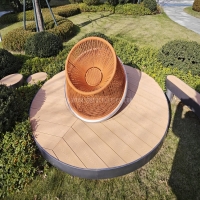Welcome to the website for landscape facilities products and knowledge.
How does the table’s design enhance or hinder collaborative work environments?
The design of tables in workspaces plays a crucial role in either fostering or inhibiting collaborative efforts among team members. Modern office environments increasingly recognize that the humble table serves as more than just a surface for placing laptops and coffee cups—it becomes the physical foundation upon which teamwork either flourishes or falters.
Traditional rectangular tables, while space-efficient, often create hierarchical dynamics with natural "head" positions that can stifle open communication. In contrast, circular and oval tables promote equality among participants, encouraging eye contact and making each team member feel equally positioned within the group. This subtle psychological effect can significantly impact participation levels, particularly among introverted team members who might feel marginalized in traditional seating arrangements.
The integration of technology represents another critical aspect of collaborative table design. Tables with built-in power outlets, USB ports, and cable management systems eliminate the frustrating "cord chaos" that often disrupts brainstorming sessions. Some advanced designs even incorporate wireless charging surfaces and integrated screens, allowing for seamless information sharing without the awkward transitions that typically accompany technology setup in meetings.
Height-adjustable tables have emerged as particularly valuable for collaborative spaces, accommodating both seated and standing work preferences. This flexibility not only supports physical comfort but also enables dynamic transitions between different working styles throughout a collaborative session. Teams can begin a meeting seated for detailed analysis, then raise the table for a more energetic brainstorming phase, adapting the physical environment to match the cognitive demands of each work phase.
Material selection and visual aesthetics also contribute significantly to the collaborative atmosphere. Transparent materials like glass can create an impression of openness and accessibility, while warm wood tones often foster a sense of comfort and approachability. The tactile experience of the table surface—whether cool granite or warm walnut—subtly influences participants' psychological state and willingness to engage openly with colleagues.
Mobility features represent perhaps the most underappreciated aspect of collaborative table design. Tables with locking casters enable teams to quickly reconfigure their workspace for different group sizes and activities. This adaptability transforms static meeting rooms into dynamic collaboration zones that can evolve throughout the day to support various work modalities—from focused small-group work to larger team presentations.
The most effective collaborative tables incorporate what designers call "boundary objects"—shared resources like whiteboard surfaces, modular component systems, or tool organizers that give team members tangible reasons to interact across the table. These integrated elements transform the table from a passive platform into an active participant in the collaborative process, providing both physical and conceptual common ground for developing ideas collectively.
As remote and hybrid work models become increasingly prevalent, table design must also accommodate video conferencing needs. Tables with integrated camera mounts, microphone systems, and thoughtful sightline considerations help bridge the gap between in-person and remote participants, ensuring that technological mediation doesn't undermine the collaborative spirit of the meeting.
Ultimately, the most successful collaborative tables are those that disappear from conscious attention while actively supporting the work happening around them. When team members don't need to think about where to plug in devices, how to see colleagues' faces, or where to sketch out ideas, they can devote their full cognitive resources to the collaborative task at hand. The table becomes an invisible facilitator rather than a visible obstacle—the silent partner in every successful collaboration.
Related search:

Recommendation
Swivel chair-Specialty steel structure woven rattan leisure chair with rotatable design